
Ahmad Shāh Durrānī, also known as Ahmad Shāh Abdālī, was the founder of the Durrani Empire and is often regarded as the founder of modern Afghanistan. In June 1747, he was appointed as King of the Afghans by a loya jirga in Kandahar, where he set up his capital.
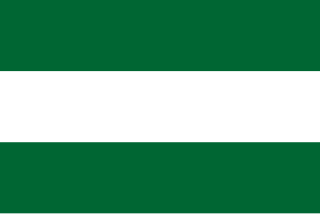
The Durrani Empire, or the Afghan Empire, also known as the Sadozai Kingdom, was an Afghan empire founded by the Durrani tribe of Pashtuns under Ahmad Shah Durrani in 1747, which spanned parts of Central Asia, the Iranian plateau, and the Indian subcontinent. At its peak, it ruled over present-day Afghanistan, much of Pakistan, parts of northeastern and southeastern Iran, eastern Turkmenistan, and northwestern India. Next to the Ottoman Empire, the Durrani Empire is considered to be among the most significant Islamic empires of the second half of the 18th century.
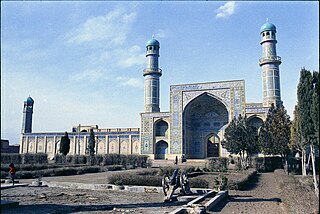
Herāt is an oasis city and the third-largest city in Afghanistan. In 2020, it had an estimated population of 574,276, and serves as the capital of Herat Province, situated south of the Paropamisus Mountains in the fertile valley of the Hari River in the western part of the country. An ancient civilization on the Silk Road between West Asia, Central Asia, and South Asia, it serves as a regional hub in the country's west.

The Kakar is a Gharghashti Pashtun tribe, based in Afghanistan, parts of Iran, and northern Balochistan in Pakistan.
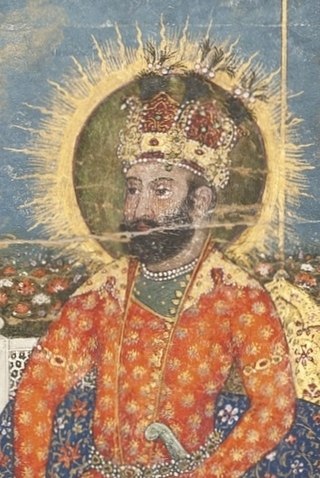
Zaman Shah Durrani, or Zaman Shah Abdali was the third King of the Durrani Empire from 1793 until 1801. An ethnic Pashtun of the Sadozai clan, Zaman Shah was the grandson of Ahmad Shah Durrani and the fifth son of Timur Shah Durrani.

The Kart dynasty, also known as the Kartids, was a Sunni Muslim dynasty of Tajik origin closely related to the Ghurids, that ruled over a large part of Khorasan during the 13th and 14th centuries. Ruling from their capital at Herat and central Khorasan in the Bamyan, they were at first subordinates of Sultan Abul-Fateh Ghiyāṣ-ud-din Muhammad bin Sām, Sultan of the Ghurid Empire, to whom they were related, and then as vassal princes within the Mongol Empire. Upon the fragmentation of the Ilkhanate in 1335, Mu'izz-uddin Husayn ibn Ghiyath-uddin worked to expand his principality. The death of Husayn b. Ghiyath-uddin in 1370 and the invasion of Timur in 1381, ended the Kart dynasty's ambitions.

The Hotak dynasty was an Afghan monarchy founded by Ghilji Pashtuns that briefly ruled portions of Iran and Afghanistan during the 1720s. It was established in April 1709 by Mirwais Hotak, who led a successful rebellion against the declining Persian Safavid empire in the region of Loy Kandahar in what is now southern Afghanistan.

The Durrani dynasty was founded in 1747 by Ahmad Shah Durrani at Kandahar, Afghanistan. He united the different Pashtun tribes and created the Durrani Empire. which at its peak included the modern-day Afghanistan, Pakistan, as well as some parts of northeastern Iran, eastern Turkmenistan, and northwestern India including the Kashmir Valley.

The Anglo-Persian War or the Anglo-Iranian War lasted between 1 November 1856 and 4 April 1857, and was fought between the United Kingdom and Iran, which was ruled by the Qajar dynasty. The war had the British oppose an attempt by Iran to press its claim on the city of Herat. Though Herat had been part of Iran under the Qajar dynasty when the war broke out, it had declared itself independent under its own rebellious emir and placed itself under the protection of the British in India and in alliance with the Emirate of Kabul, the predecessor of the modern state of Afghanistan. The British campaign was successfully conducted under the leadership of Major General Sir James Outram in two theatres: on the southern coast of Persia near Bushehr and in southern Mesopotamia.

The siege of Kandahar began when Nader Shah's Afsharid army invaded southern Afghanistan to topple the last Hotaki stronghold of Loy Kandahar, which was held by Hussain Hotaki. It took place in the Old Kandahar area of the modern city of Kandahar in Afghanistan and lasted until March 24, 1738, when the Hotaki Afghans were defeated by the Persian army.

The campaigns of Nader Shah, or the Naderian Wars, were a series of conflicts fought in the early to mid-eighteenth century throughout Central Eurasia primarily by the Iranian conqueror Nader Shah. His campaigns originated from the overthrow of the Iranian Safavid dynasty by the Hotaki Afghans. In the ensuing collapse and fragmentation of the empire after the capture of the Iranian capital of Isfahan by the Afghans, a claimant to the Safavid throne, Tahmasp II, accepted Nader into his service. After having subdued north-west Iran as well as neutralising the Abdali Afghans to the east and turning Tahmasp II into a vassal, Nader marched against the Hotaki Afghans in occupation of the rest of the country. In a series of incredible victories the Afghans were decimated and Tahmasp II returned to the throne as a restored Safavid monarch.
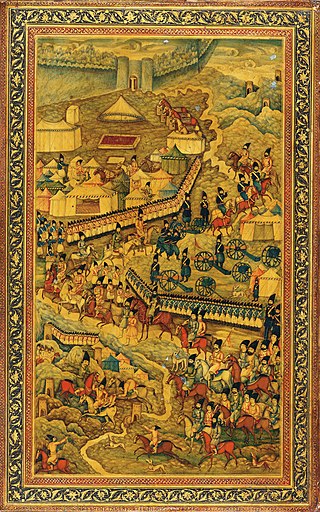
The First Herat War was an attack on the Principality of Herat by Qajar Iran during the Great Game. Herat was held by Kamran Shah and his vizier Yar Mohammad Khan Alakozai. The Shah of Persia was Mohammed Shah Qajar. Four Europeans were involved: the British, Sir John McNeill and Eldred Pottinger as well as the Russians, Count Simonich and Jan Prosper Witkiewicz. Sher Mohammad Khan Hazara, an ally of Kamran and chieftain of the Qala-e Naw Hazaras, helped form a Sunni confederacy of Aimaq, Turkmen, and Uzbek tribes and played a crucial role in defending Herat when the city was besieged. The siege ended when neither side gained a clear advantage, the British threatened to take military action and the Russians withdrew their support.
The following is a timeline of the history of the city of Herat, Afghanistan.
The Battle of Sangan, was an engagement involving the Loyalist forces of Tahmasp II of Safavid Iran led by Nader and the Abdali Afghan tribes in and further beyond southern Khorasan in the autumn of 1727. This armed struggle was one of the initial battles between the resurgent Safavid cause and that of the Afghans. The engagement technically ended in a Safavid victory.

The Sabzevar expedition was a politically decisive event in Nader's career where he in effect turned from mere commander-in-chief of Tahmasp's forces into the real power behind the throne. The expedition was launched mainly due to Tahmasp's own incompetence and ill-thought attempt at curbing the powers of his upstart general and military genius.

The Campaign of Herat consisted of a series of intermittent and fluid engagements culminating in the finale of Nader's military operations against the Abdali Pashtuns. Nader having recently concluded a successful campaign against his own monarch and prince, the badly humiliated Tahmasp II, set out from Mashad on 4 May 1729, making sure that the Shah also accompanied him on this journey where he could be kept under close supervision.
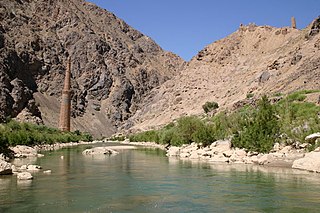
The Battle of Kafer Qal'eh was a series of clashes which decided the outcome to the Herat Campaign. In its culminating stage the battle bears some resemblances to the battle of Sangan although it was both preceded and succeeded by numerous other minor skirmishes and engagements.

The Herat Campaign of 1731 took place when Nader Shah who had already successfully driven the Ottomans from western Iran and southern Azerbaijan had to cut his campaign short to deal with the revolt of the Abdalis of Herat who were provoked into bearing arms against their Persian overlords by Hussein Hotaki of Qandahar. The conflict resulted in the re-establishment of Persian rule over Herat.

The Guarded Domains of Iran, commonly referred to as Afsharid Iran or the Afsharid Empire, was an Iranian empire established by the Turkoman Afshar tribe in Iran's north-eastern province of Khorasan, establishing the Afsharid dynasty that would rule over Iran during the mid-eighteenth century. The dynasty's founder, Nader Shah, was a successful military commander who deposed the last member of the Safavid dynasty in 1736, and proclaimed himself Shah.

The Second Herat War was the invasion of the surrounding realm of Herat and the successful siege of its citadel by the Qajar army led by Hesam o-Saltaneh, Soltan Morad Mirza. The 1856 siege was part of the concerted Qajar effort to compensate the recent territorial losses in the Russo-Persian Wars of 1804–1813 and 1826–1828 by reconquering western Afghanistan, which had historically been a part of Persia's domain. The conflict was also a part of the broader Great Game between the British Empire and the Russian Empire.


















